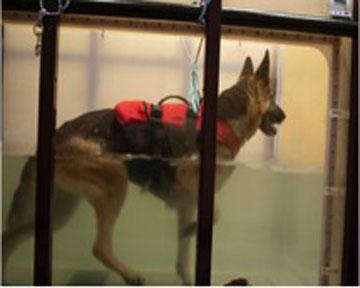Minimally Invasive Surgery in Soft Tissue Applications
- Mar, 13, 2016
- DVSC
- Medical Library
- Comments Off on Minimally Invasive Surgery in Soft Tissue Applications
In addition to arthroscopy, the DVSC offers a complete array of thoracoscopic, laparoscopic and laparoscopic assisted procedures. As the demand for minimally invasive soft tissue procedures has grown, so has our commitment to providing cutting edge care for our small animal patients. The advantages of laparoscopic procedures versus open procedures are similar to our arthroscopy […]
Read MoreNeurosurgical Postoperative Physical Therapy
- Mar, 12, 2016
- DVSC
- Medical Library
- Comments Off on Neurosurgical Postoperative Physical Therapy
Many patients with medically and surgically managed neurological disorders greatly benefit by postoperative rehabilitation and physical therapy. The DVSC is associated with a team of dedicated physical therapists trained in the human field that can develop a tailored physical therapy program for each pet to aid in the rehabilitation process. Techniques such as swimming, static/dynamic […]
Read MorePerianal Fistula Management in Dogs
- Mar, 11, 2016
- DVSC
- Medical Library
- Comments Off on Perianal Fistula Management in Dogs
Perianal Fistula Management in Dogs Perianal fistulas are a common cause of perineal and tail irritation in dogs. Large breed dogs, especially German Shepherds, are overrepresented. Historically, treatment has consisted of various invasive procedures, including debridement/excision, fulguration, laser treatment and chemical debridement. Failure rates with surgical treatment are high, including recurrence of the fistulas and […]
Read MorePerineal Hernias
- Mar, 10, 2016
- DVSC
- Medical Library
- Comments Off on Perineal Hernias
What is a perineal hernia? Perineal hernia is a condition where the muscles in the pelvis weaken and separate allowing organs and tissues to prolapse through this new space. A swelling adjacent to the anus may occur as a result. Older intact male dogs (un-neutered) are the most commonly affected, although it can occur in […]
Read MorePeritoneopercardial Hernias in Dogs and Cats
- Mar, 09, 2016
- DVSC
- Medical Library
- Comments Off on Peritoneopercardial Hernias in Dogs and Cats
Peritoneopericardial hernias (PPH) are an unusual sub type of diaphragmatic hernias. PPH occur secondary to incomplete separation of the diaphragm from the pericardium during embryogenesis, and are considered to be a congenital defect. Many PPH are discovered as an incidental finding during routine thoracic and/or abdominal radiographs.Typical findings include enlargement of the cardiac silhouette and […]
Read MorePortosystemic Shunts
- Mar, 08, 2016
- DVSC
- Medical Library
- Comments Off on Portosystemic Shunts
What is a portosystemic shunt? A portosystemic shunt occurs when the blood from the intestines (carried by the portal vein) enters into the systemic circulation without first passing through the liver. This becomes a problem because the liver normally filters the toxins contained in the portal blood before it passes to the rest of the […]
Read MoreSpinal Fractures and Subluxations
- Mar, 07, 2016
- DVSC
- Medical Library
- Comments Off on Spinal Fractures and Subluxations
Fractures land luxations of the cervical and thoracolumbar spine (Figure 1) are commonly managed at the DVSC. Options for treatment include surgical stabilization or conservative treatment with external braces, confinement, and analgesics. The best course of treatment depends on the neurologic status and health of the patient and the expectations of the owne Several […]
Read MoreSplenectomy
- Mar, 06, 2016
- DVSC
- Medical Library
- Comments Off on Splenectomy
Hemoabdomen, or hemoperitoneum, is an accumulation of blood in the abdominal cavity. The condition is a common reason for emergency presentation of pets to the veterinary hospital. While hemoabdomen does occur in cats, it is a more commonly seen condition in dogs. Any age or breed of dog or cat may be afflicted with this […]
Read MoreTotal Hip Replacement
- Mar, 05, 2016
- DVSC
- Medical Library
- Comments Off on Total Hip Replacement
Overview: Total hip replacement is a surgical procedure which reliably restores comfort and near normal function to dogs with a variety of painful hip conditions. Advantages include relatively quick recovery, predictable results, and options if complications are encountered. Disadvantages are cost, and need for extended exercise restriction. Indications: The most common condition for which […]
Read MoreTriple Pelvic Osteotomy (TPO)
- Mar, 04, 2016
- DVSC
- Medical Library
- Comments Off on Triple Pelvic Osteotomy (TPO)
Triple pelvic osteotomy (TPO) remains a valuable surgery in the prevention of degenerative joint disease secondary to hip laxity. The surgeons at DVSC recommend that hips of susceptible breeds be palpated beginning at 4-6 months of age. If laxity is detected, owners should be informed about the benefits of the TPO procedure. The basis […]
Read MoreSearch This Site
Medical Library Posts
- 25+ Years of Neurosurgery at the DVSC
- Anal Sac Adenocarcinoma
- Anal Sac Removal, Elective
- Arthritis
- Arthroscopy
- Atlanto-axial (A-A) instability
- Coxofemoral (Hip) Luxation
- Cranial Cruciate Ligament (CCL) Overview
- Cranial Cruciate Ligament (CCL) – Extracapsular Repair
- Cranial Cruciate Ligament (CCL) – Tibial Plateau Leveling Osteotomy (TPLO)
- Cranial Cruciate Ligament (CCL)-Tibial Tuberosity Advancement (TTA)
- Cutaneous Mast Cell Tumors
- Cystotomy and Scrotal Urethrostomy
- Degenerative Myelopathy
- Diaphragmatic Hernia
- Diskospondylitis
- Ear Canal Ablation and Bulla Osteotomy
- Elbow Dysplasia
- Epidural Analgesia
- Episioplasty
- Feline Perineal Urethrostomy
- Femoral Head Ostectomy (FHO)
- Fibrocartilaginous Embolism (FCE)
- Fibrocartilaginous Embolus in Schnauzers
- Fracture Healing by Biologic Osteosynthesis
- Fracture of the Radius and Ulna in Small breed dogs
- Fracture Repair by Circular External Skeletal Fixator (ESF)
- Gastric Dilatation-Volvulus (Bloat)
- Gastrointestinal Foreign Body
- Gastropexy, Elective
- Hip Dysplasia (Overview)
- Hip (Coxofemoral) Luxation
- Incontinence: Urethral Sphincter Mechanism Incompetence
- The Facts About Backs (IVDD)
- Intervertebral Disc Disease (IVDD) Percutaneous Laser Disc Ablation LDA
- Intervertebral Disc Disease (IVDD)- Care of a Paralyzed Pet
- Laryngeal Paralysis
- Lumbosacral Disease
- Mandibulectomy and Maxillectomy
- Medial Patellar Luxation (MPL)
- Microvascular Dysplasia Mimics Portosystemic Shunt
- Minimally Invasive Surgery in Soft Tissue Applications
- Neurosurgical Postoperative Physical Therapy
- Perianal Fistula Management in Dogs
- Perineal Hernias
- Peritoneopercardial Hernias in Dogs and Cats
- Portosystemic Shunts
- Sialocele (Salivary Mucocele)
- Spinal Fractures and Subluxations
- Splenectomy
- Total Hip Replacement
- Tracheal Collapse
- Triple Pelvic Osteotomy (TPO)
- Underwater Treadmill
- Updates in Fracture Management
- Urethral Prolapse
- Wobblers Disease









